Leonardo Fibonacci – An Italian Mathematician
Scanty evidence reveals us very little about Fibonacci’s life. Just a few facts that were immortalized in his mathematical literature actually convey us who Leonardo Fibonacci really was. An Italian mathematician, known as Leonardo of Pisa or Leonardo Pizano, he was born around 1170 in Pisa, Italy, and died after c. 1240. He occasionally called himself “Bigollo” which, in the sense, is associated with a traveler, a lazy person or absolutely nothing. He frequently traveled with his father, Guglielmo Bonacci, who was at that time consul of the Pisan merchants’ community in Algeria. Such lifestyle, certainly, enabled him to study calculus from an Arab master of calculation. He elaborated and studied various numerical systems and methods of calculation in Egypt, Syria, Greece, Sicily and Provence, but he still acquired most of his tutelage in North Africa.
While in Africa, Fibonacci noticed that merchants there used a completely different method of well-formed scripting numbers, nothing like the one used in Europe at the time. This method, emerging from India, was transferred by the logic of trade practice to the Middle East, and then to Africa. It consisted of nine digits: 1, 2, 3, 4, 5, 6, 7, 8, 9, and a special character “0” which denoted a zero or nothing. He also encountered the Arabic and Indian science, with algebra and a positional system, which was simplified and easier to record.
Based on his general knowledge that he collected gradually, after returning to his hometown of Pisa, Fibonacci wrote numerous and significant manuscripts, and his first masterpiece “Liber Abbaci” (“The Book of Calculation”), was published in 1202. When the Fibonacci’s “Book of Calculation” was first introduced to the public, only individuals in intellectual circles were well aware of the Hindu-Arabic digits and exclusively through the translated papers of the Arab mathematician al- Khwarizmi. For the next three centuries, it turned out that this most important European mathematical script introduced Arabic digit notation by demonstrating the usage of numbers in arithmetic operations, allowing Fibonacci to alter the trade technology and accounting on a long-term basis. The presented techniques were applicable onto highly practical problems such as profit markup, money exchange, weight and measurement conversion, and much more.
Majority of his published works were based on ratios, such as “rule of three” or “rule of five” that are in use for the proportion ratio. Furthermore, there was the “regula falsi,” i.e. a method of deconstructing a problem via a false presupposition, and then of correcting it via a proportion with adequate geometry and algebra. In 1220, Fibonacci published a short work, “Practica geometriae” (“Geometrical exercises”), based on Euclid’s theorems, elements and divisions.
It is an interesting fact that he published his works in manuscripts, since Gutenberg’s printing machine had not been invented yet; and that Europe held him in a high regard. He was greatly admired by even the Holy Roman Emperor, Frederick II. In this regard, Fibonacci kept in touch with Frederick II and his scientific researchers by exchanging letters for several years, to deliberate their thoughts and mathematical problems.
In 1225, Fibonacci published the “Liber quadratorum” (“The Book of Squares”) which was influenced by Diophantine’s equations to the second power, i.e. quadratic equation. “The Book of Squares” is an all-encompassing collection of theorems, many of which were defined by the author. What’s more, he relied on his own evidence to prove general solutions. Mathematicians claim that this was “Fibonacci’s most creative work with congruent numbers, i.e. numbers with the same remainder when divided by the given number. He also elaborated on and presented a genuine solution to finding a number, which, when added or subtracted from a squared number, leaves a squared number. “The Book of Squares” is considered a masterpiece of his mathematical opus to this day.
Izvori: Gies, Frances Carney. “Fibonacci”. Encyclopedia Britannica, 5 Oct. 2021.



